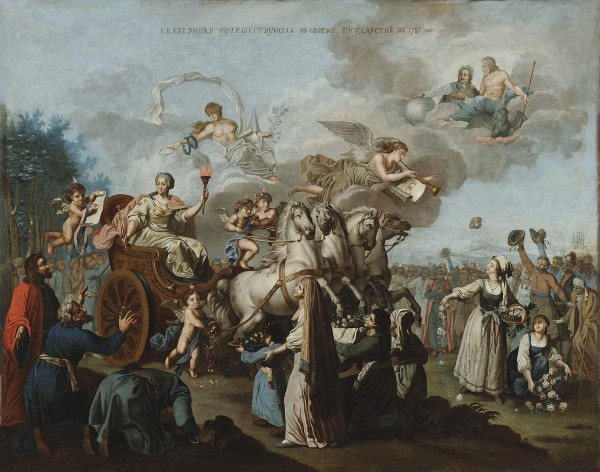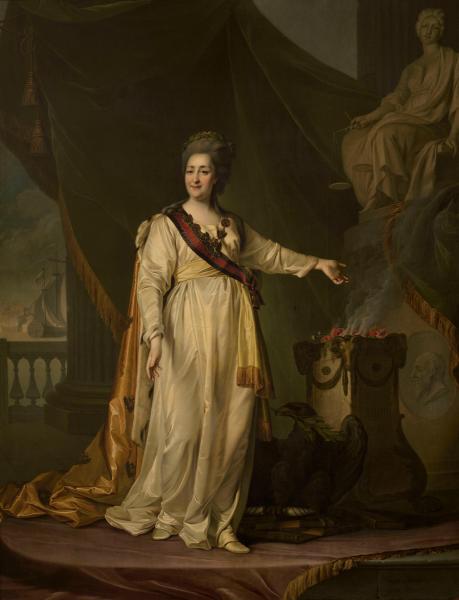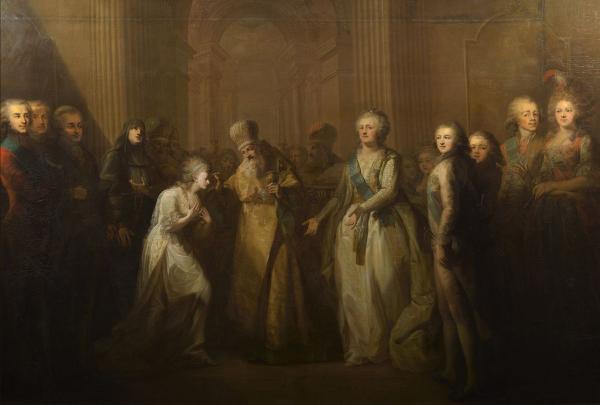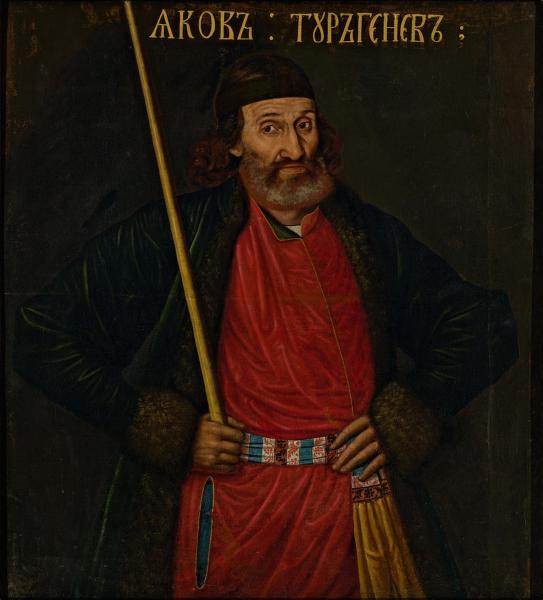The artist is unknown

Catherine II was the first of the Russian tsarist persons to make big trips in their country, not related to military operations. The trips were furnished with great splendor and continued for many months, being important political events. In addition to the retinue accompanying the Empress, statesmen, senators, officials, foreign ambassadors rode with her. During trips, Catherine met with representatives of different segments of the population, inspected the work of the local administration.
The longest (7 months) was the journey of 1787 to Crimea. Part of the way passed along the Dnieper on rowing ships. Near Kyiv, the empress met with the Polish king Stanislav August, and near Kremenchug with the Austrian emperor Joseph II. It is the last journey that is depicted on the canvas: among the subjects of a man and a woman who are welcoming the empress, both in European and oriental costumes.
Elena Stolbova. Exhibition catalog in Malaga "The Romanov dynasty". 2017. With. 234.
Ekaterina II Great (Ekaterina Alekseevna Romanova (1729–1796)-nee Princess Sofia Augustus Frederick Angalt-cords. Born in the German city of Stetin. The eldest daughter of the Duke of Christian Augustus Angalt Tserbst (1690–1747) and Duchess of Johanna Elizabeth Golstein-Gottorp (1712–1760). In 1744, she arrived in Russia as the bride of Grand Duke Peter Fedorovich, the future Emperor Peter III. In the same year she accepted Orthodoxy with the name of Ekaterina Alekseevna and was married to Peter Fedorovich in August 1745. From 1745 – Grand Duchess, a son was born in a marriage – Grand Duke Pavel Petrovich, future emperor Paul I (1754–1801). She did not work out with her husband, and Peter III intended to send his wife to the monastery. In the summer of 1762 she headed the guards and overthrew Peter III, becoming an empress. In the early years of government, it adhered to politics "enlightened absolutism", But after the peasant war, led by Emelyan Pugachev (1773-1775) and the great French bourgeois revolution (1789), she was forced to tighten the regime. Woned the victorious wars with Turkey (1768-1774; 1787-1792) and Sweden (1788-1790). During its reign, Russia included Crimea (1783), North Black Sea region, Baltic states, eastern parts of Poland, Aleutian Islands, Russian settlements in Alaska were created, Eastern Georgia was taken under patronage. The prestige of Russia in Europe has grown many times.
Olga Savenkova. Exhibition catalog in Malaga "The Romanov dynasty". 2017. With. 229.
+ About the restoration of the work
– Hide the text about restoration
The state of safety before restoration:
The picture was stored for a long time in a horizontal position, without a subframe. In the lower right corner and around the perimeter there were losses of the basis. The back is covered with a waxing layer. This tool was used in the 18th – beginning of the XIX century to protect paintings from moisture and mold. The canvas of the canvas is stitched, with one horizontal seam. The entire length of the seam has a rigid crack of the soil and a colorful layer. On the perimeter along the edges there were nail punctures from the previous stretch of the picture to the subframe. Due to the fact that the author’s edges were absent, the picture was stretched on a smaller subframe beyond the author’s edges with painting. There was a denser layer of darkened varnish on the edges of the picture. The surface of the painting was very contaminated, darkened, looked uneven.
Complex of the events:
At the first stage, the strengthening of a colorful layer with the exfoliation was performed. A layer of waxing mastic was removed from the back, the losses of the base were made up, punctures were made, and the seam level was leveled. The author’s base is duplicated on the new canvas. Then the picture is stretched on a new exposition subframe made in accordance with the original size of the author’s painting. Pollution was removed from the surface of the painting, later layers of varnishes and records were removed. The lower lacquer layer is specified and leveled. In the upper part of the image of the sky, the inscription was revealed describing the plot of the composition.
At the second stage of restoration, restoration soil is summed up in loss, painting is covered with a protective layer of varnish, tinting with oil paints is made.
As a result of restoration, the author’s size was restored, cleared author’s painting became a bright, cold tone. The author’s inscription is disclosed, which is of important historical meaning.
Keeping a story. Restoration workshop of the Russian Museum – 100 years. SPb, 2022. With. 112.


